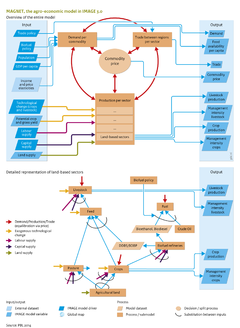Agricultural economy: Difference between revisions
Jump to navigation
Jump to search
No edit summary |
No edit summary |
||
| Line 1: | Line 1: | ||
{{ComponentTemplate2 | {{ComponentTemplate2 | ||
|Application=Eururalis (2007) project; Millennium Ecosystem Assessment - MA (2005) project; Global Environmental Outlook - GEO4 (2007) project; AgMIP and ISI-MIP project; The Protein Puzzle (2011) project; | |Application=Eururalis (2007) project; Millennium Ecosystem Assessment - MA (2005) project; Global Environmental Outlook - GEO4 (2007) project; AgMIP and ISI-MIP project; The Protein Puzzle (2011) project; | ||
|IMAGEComponent=Drivers; Land-use allocation; | |IMAGEComponent=Drivers; Land-use allocation; | ||
|ExternalModel=EFIGTM model; | |ExternalModel=EFIGTM model; | ||
| Line 13: | Line 13: | ||
Although MAGNET is the standard agro-economic model used with IMAGE, other models can be linked with IMAGE. For example, the [[IMPACT model]] was used with IMAGE in the [[Millennium Ecosystem Assessment - MA (2005) project|Millennium Ecosystem Assessment]] ([[Carpenter et al., 2006]]), and in a [[The Protein Puzzle (2011) project|PBL study on protein supply]], both the [[MAGNET model|MAGNET]] and the [[IMPACT model|IMPACT]] model were used to study the same set of scenarios. This allowed a systematic comparison between IMPACT and MAGNET ([[Stehfest et al., 2013]]). | Although MAGNET is the standard agro-economic model used with IMAGE, other models can be linked with IMAGE. For example, the [[IMPACT model]] was used with IMAGE in the [[Millennium Ecosystem Assessment - MA (2005) project|Millennium Ecosystem Assessment]] ([[Carpenter et al., 2006]]), and in a [[The Protein Puzzle (2011) project|PBL study on protein supply]], both the [[MAGNET model|MAGNET]] and the [[IMPACT model|IMPACT]] model were used to study the same set of scenarios. This allowed a systematic comparison between IMPACT and MAGNET ([[Stehfest et al., 2013]]). | ||
In IMAGE, demand for forest products can be derived from several sources, the most simplest being via a relationship with GDP or preferably, from specific forest demand models, such as [[EFIGTM | In IMAGE, demand for forest products can be derived from several sources, the most simplest being via a relationship with GDP or preferably, from specific forest demand models, such as [[EFIGTM model|EFI-GTM]] ([[Kallio et al., 2004]]). In the future, competition between forestry and other land uses can be included using the forestry module in MAGNET. Other land-use changes, such as infrastructure expansion, which do not require interregional links, are described in the [[Land-use allocation|land-use allocation]] model). | ||
|ComponentCode=AEF | |ComponentCode=AEF | ||
|AggregatedComponent=Agriculture and land use | |AggregatedComponent=Agriculture and land use | ||
|FrameworkElementType=pressure component | |FrameworkElementType=pressure component | ||
}} | }} | ||
Revision as of 15:58, 21 May 2014
Parts of Agricultural economy
| Component is implemented in: |
|
| Related IMAGE components |
| Projects/Applications |
| Key publications |
| References |
Key policy issues
- What is the area of cropland and grassland required to support future food demand?
- What are the policy options to reduce agricultural land use and to safeguard global biodiversity, while ensuring food security?
- How can the implications of biofuels for land use and greenhouse gases be managed sustainably?
